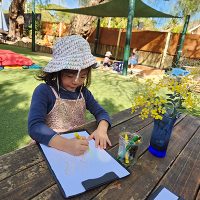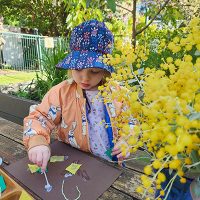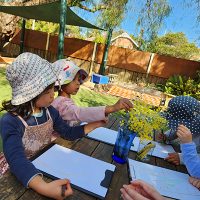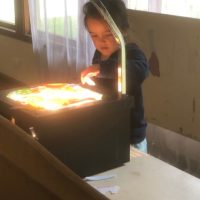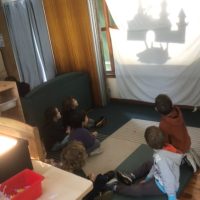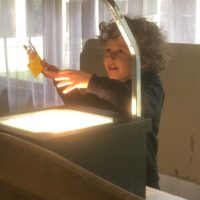Johnson House
Preschool
Story by Educator Alisa
The children in Johnson House preschool have been learning about the different seasons. As part of this learning, some Golden Wattle flowers were made available to the children. Having explained that the Golden Wattle, or Acacia pycnantha, is the national flower of Australia, the children were curious to find more about these flowers. They examined the flowers which led to a discussion of their attributes such as the shapes, colours, textures, smell, and the structure of the plant’s leaves, stems and flowers. Some of the descriptions the children used included: “It looks like small yellow, fluffy pompom balls”, “It smells like shampoo”, “It smells fresh”, “The leaves are soft and velvety” and “The flowers look different… but it still has green leaves”.
As some of the children had not seen Golden Wattle flowers before, they asked where they could be found, and they were surprised to find out that there is a Golden Wattle growing on Henry Street. One of the children shared, “I saw these flowers in the morning when I went to Johnson House. There were lots of small yellow flowers.” I suggested to the children to look for this tree as they walk home or to their car with their families.
Apparently, this variety of Golden Wattle starts to bloom by the end of May. If the children happen to pass by the tree on Henry Street, they will smell the fresh-smelling scent of the Golden Wattle which means that winter has arrived!
The children were invited to create their own representations of the Golden Wattle using different media. They were provided with yellow, green and brown crayons, and they also explored scrunching up crepe paper to make bunches of the small yellow flowers.
Through this experience, the children examined the Golden Wattle using their senses of sight, touch and smell, which further supported their exploration of the plant’s unique attributes. They continued to learn about their immediate natural environment and how to pay attention to the changes that happening around them. This also provided opportunities for the children to use different media to represent their golden flowers and further develop their emerging creativity and fine motor skills.
Robinson House
Story by Educator Andrew
Today in Robinson House we continued looking at shadow puppetry, and we were even lucky enough to have had a few new puppeteers/audience members who were eagerly joining us for the first time.
The group made their way to the front room where the puppet theatre was set up and ready to go.
Frank had asked if he could go first, as he has become quite the expert at using the felt pieces of late. He confidently shared a wonderful demonstration of his puppetry skills with the group using the felt shapes. The other children were all very excited about the opportunity to entertain their friends with their own unique stories.
Some of us chose to place the pieces down carefully on the glass to tell a specific story, whilst others were happy just experimenting with the shadows being cast on the wall. We even discovered that if you combine different shapes, such as a bird and a dog, you get the shadow of a flying dog, which the group found hilarious and which was the catalyst for many other humorous creations.
The experimentation with the shadows posed the question of what else, beside felt board pieces, could we use to create shadows that could be used for storytelling? Next time we may look at manipulating our hands and bodies to see else what we can create. Wonderful work everyone!
Community Playgroups
Story by Playgroup Coordinator Rebecca
At our Baby Time playgroup parents and carers have been asking about homemade toys for babies, and how to make these and what is safe.
There are many toys that can be made at home for babies that are fun, safe and have learning benefits. A ‘Sensory bottle’ can be made using a clear, empty plastic bottle of whatever size you choose. The bottle can be filled with a base element such as shaving cream, hand sanitizer, water or oil (or it can have no base element at all), and then have add ins such as rice, pasta, paper, glitter, small pom poms or buttons to create visual, tactile and auditory interest. It is important to ensure that once the materials have been added to the bottle that the lid is closed tightly and securely and reinforced with a strong adhesive such as gaffer or electrical tape to prevent the lid from being removed. You should ensure that your baby is supervised at all times while playing with the sensory bottle/s.
Playing with sensory bottles helps babies to develop their sense of touch and their fine motor skills as they move the bottle around to see the objects inside move, and this will also help to develop and strengthen your baby’s hand-eye coordination. The types of sensory bottles you can make are endless! Get creative and use things from around your home or from the craft shop, and check websites such as Pinterest for some great ideas.
